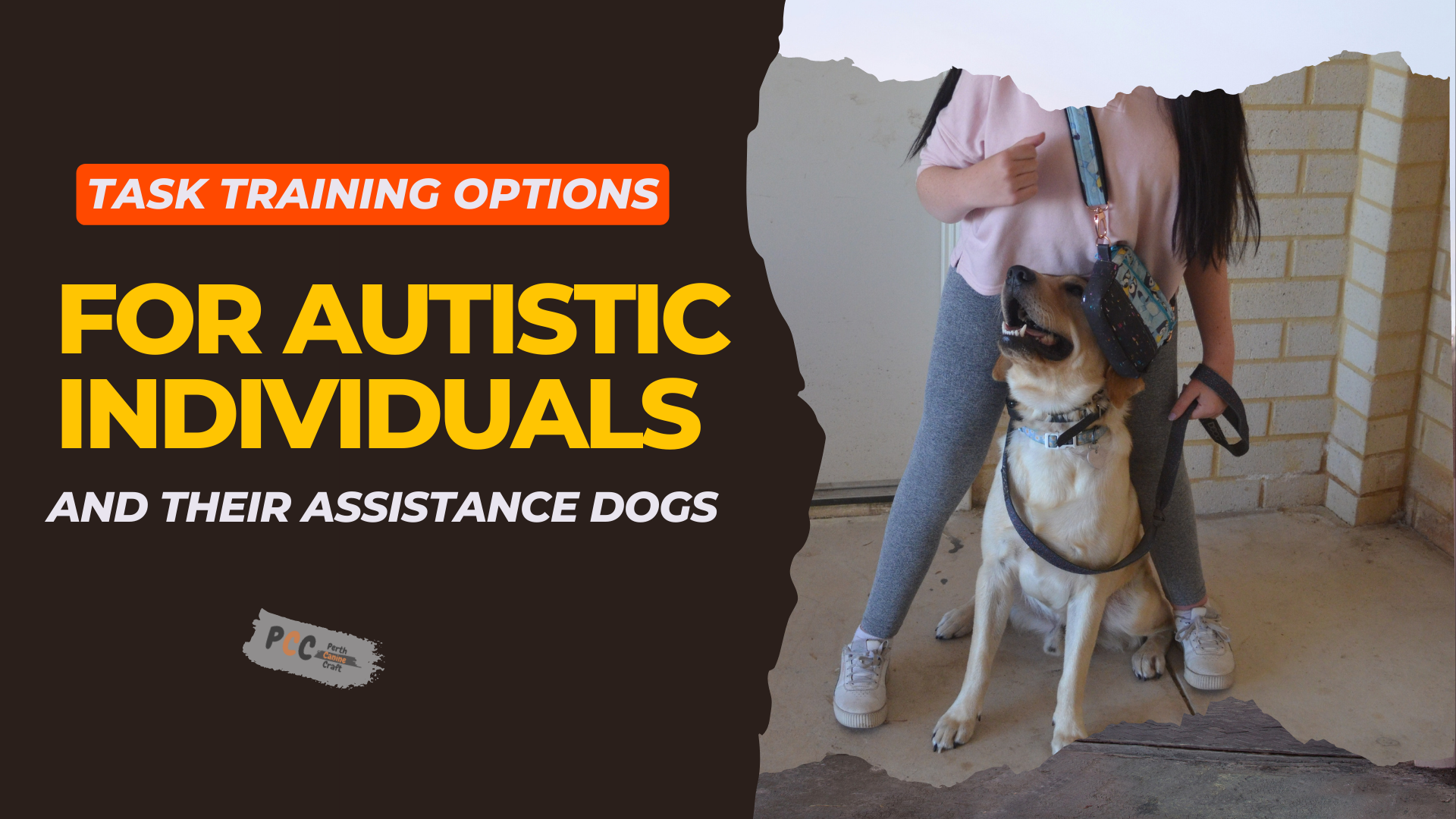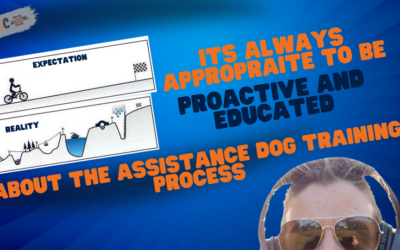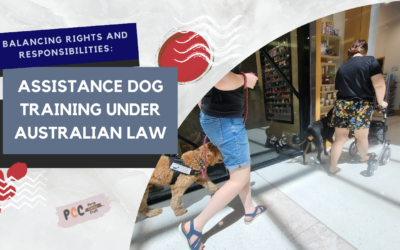The Benefits of Autism Assistance Dogs
Autism assistance dogs provide emotional support, companionship, and help with specific tasks for autistic individuals. It’s essential to recognize that each person has unique needs, and task training should be customized accordingly. Here, we discuss various task training options for autism assistance dogs in greater detail, with examples for each point.
-
Deep Pressure Therapy
Trained dogs can apply deep pressure therapy by laying across the child’s lap or pressing against their body, which calms the child during stressful situations.
Example: During a sensory overload episode, the assistance dog lies on the child’s legs or hugs them from behind, providing comfort through deep pressure therapy and helping to regulate their emotions.
-
Tethering
Teaching the dog to wear a harness that the child holds onto provides security and prevents wandering. It also improves the child’s sense of independence. Please note that it is a technique that will only be considered if the child is not a danger to the dog when they are unable to go where they want.
Example: In crowded environments like malls or amusement parks, the tethered dog helps the child stay close to their caregiver, giving them the confidence to explore while ensuring their safety.
-
Interrupting Harmful Behaviors
Dogs can learn to recognize and interrupt repetitive or harmful behaviours, such as self-harming, hair pulling, or excessive rocking.
Example: When the child starts to hit their head against a wall, the dog gently places its body between the child and the wall, interrupting the harmful behavior and offering comfort.
-
Sensory Processing Support
Assistance dogs can identify sensory overload and guide the child to a quieter, more comfortable environment.
Example: At a loud concert, the dog senses the child’s discomfort and leads them to a designated quiet area, providing relief from sensory overload.
-
Social Bridge
Dogs can facilitate social interactions, helping the child develop social skills and fostering connections with peers.
Example: At a community event, the dog’s presence encourages conversation between the child and other attendees, making it easier for the autistic child to form friendships and feel included.
-
Emotional Support
Dogs offer unconditional love, companionship, and a calming presence, which can be particularly helpful during moments of anxiety or emotional distress.
Example: After experiencing bullying at school, the child finds solace and emotional support in the dog’s presence, helping them to process their feelings and recover more quickly.
-
Physical Contact
Dogs can initiate comforting physical contact during anxious moments, such as nuzzling, resting their head on the child’s lap, or laying across the child’s feet, helping to reduce stress and anxiety levels.
Example: Sensing the child’s anxiety during a dental appointment, the dog lays at their feet, providing a calming presence and a reassuring touch.
-
Calming Presence
The dog’s consistent calm behaviour, even in unfamiliar situations, can help ease the child’s anxiety and make new experiences more manageable.
Example: On a family vacation, the dog’s calm demeanour helps the child feel more at ease in an unfamiliar hotel room, allowing them to relax and enjoy the trip.
-
Playtime and Exercise
Playing with the service dog releases endorphins, reduces anxiety, and improves mood. Engaging in physical activity together also promotes overall health and well-being.
Example: The dog encourages the child to play fetch in the park, providing physical exercise, stress relief, and an opportunity for the child to practice social skills with other park-goers.
-
Providing Routine
The dog’s consistent presence in daily routines offers structure and predictability, which can be especially beneficial for autistic individuals who may struggle with change.
Example: The dog accompanies the child through their morning routine, including getting dressed, brushing teeth, and eating breakfast, providing a sense of stability and structure.
-
Building Confidence
Caring for their service dog can help the child develop self-confidence and social comfort. The bond between the child and the dog can also help the child feel more at ease in social situations.
Example: The child takes pride in grooming, feeding, and walking their dog, building self-esteem and confidence. They also feel more comfortable attending social events, knowing their dog is by their side for support.
-
Alerting Caregivers
Dogs can be trained to alert caregivers during meltdowns, elopement attempts, or distress, ensuring timely intervention and additional support when needed.
Example: If the child experiences a meltdown in their bedroom, the dog barks or runs to the caregiver, signalling that the child requires assistance.
-
Search and Rescue
Dogs can learn to search for and locate the child if they wander off or hide during a meltdown or anxiety episode, ensuring their safety and reducing caregiver stress.
Example: During a stressful situation, the child hides under the bed; the dog locates them and alerts the caregiver, who can then offer comfort and support.
-
Blocking
Dogs can create a physical barrier between the child and potential triggers or overstimulating environments, reducing anxiety and helping the child feel more secure.
Example: In a crowded school hallway, the dog positions itself between the child and other students, preventing unwanted contact and creating a sense of personal space.
-
Helping with Transitions
Dogs can assist during transitions between activities or environments, providing a consistent and comforting presence that eases the child’s anxiety.
Example: When moving from one class to another, the dog stays close, offering emotional support and helping the child adjust to the new environment more easily.
-
Medication Reminders
Dogs can be trained to recognize and alert the child when it’s time to take their medication, ensuring that important routines are maintained.
Example: The dog nudges the child and brings the medication container when it’s time for their daily dose, helping the child stay on track with their prescribed treatment plan.
-
Assistance with Daily Routines
Dogs can be trained to participate in the child’s daily routines, such as getting ready for school or bedtime, providing a sense of stability and predictability.
Example: At bedtime, the dog follows the child through their routine, including teeth brushing and storytime, providing comfort and a familiar presence.
-
Offering a “Job”
Dogs can be taught to carry a small backpack with the child’s belongings, giving the child a sense of responsibility and connection to their service dog.
Example: The child feels a sense of pride and accomplishment as they help their dog put on the backpack, knowing they are both working together to carry essential items.
In conclusion, autism assistance dogs can provide a wide range of support for autistic individuals, addressing their unique needs and challenges. Training options should be customized to best suit the child’s specific requirements, helping them navigate daily life with greater ease and confidence.





I have trainer two school therapy dogs during Covid and now have a third ready to go through the process. I live in Kalgoorlie and K9support in Victoria was the only company the was able to help in in the past.
I have a 12 month old golden lab nearly ready to do her school therapy dog exam. But I would like to do a little more work with her as she works with quite a few students at our school with autism.
Can you help me
Heya Jo, it depends, how old is your dog? Feel free to email me at [email protected]/au